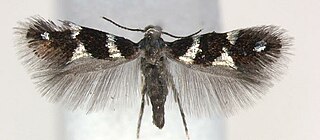A mark of distinction, in heraldry, is a charge showing that the bearer of a shield is not descended by blood from the original bearer. The "mark of distinction" usually refers to a context of illegitimacy, the illegitimate offspring being regarded as a "stranger in blood" to his natural father. The mark of distinction may also be applied upon the adoption of a surname and arms of a family from whom the bearer is not descended.

The Heliozelidae, commonly known as shield-bearer moths, are a family of small, day flying monotrysian moths distributed worldwide. The larvae of most heliozelid species are leaf miners who cut distinctive shield-shaped cases from the surface of the host leaf, hence the common name. Some species are considered pests of commercial crops such as grapevines, cranberries, and walnuts. The taxonomy of this family is poorly understood.

Dexter and sinister are terms used in heraldry to refer to specific locations in an escutcheon bearing a coat of arms, and to the other elements of an achievement. Dexter indicates the right-hand side of the shield, as regarded by the bearer, i.e. the bearer's proper right, and to the left as seen by the viewer. Sinister indicates the left-hand side as regarded by the bearer – the bearer's proper left, and to the right as seen by the viewer. In vexillology, the equivalent terms are hoist and fly.
Coptodisca arbutiella, the madrone shield bearer, is a moth of the family Heliozelidae. It was described by August Busck in 1904. It is found in western North America from California to British Columbia.
Coptodisca cercocarpella, the curl-leaf mountain mahogany leafminer, is a moth of the family Heliozelidae. It was described by Annette Frances Braun in 1925. It is found in North America, including Arizona, California, Utah and Colorado.
Coptodisca condaliae is a moth of the family Heliozelidae. It was described by August Busck in 1900. It is found in Florida.
Coptodisca diospyriella is a moth of the family Heliozelidae. It was described by Vactor Tousey Chambers in 1874. It is found in North America, including Florida, Kentucky and Ohio.
Coptodisca ella is a moth of the family Heliozelidae. It was described by Vactor Tousey Chambers in 1871. It is found in North America, including Tennessee.
Coptodisca saliciella is a moth of the family Heliozelidae. It was described by Clements in 1861. It is found in North America, including California and Ohio.
Coptodisca juglandella is a moth of the family Heliozelidae. It was described by Vactor Tousey Chambers in 1874. It is found in North America, including California, Ohio and Illinois.

Coptodisca lucifluella is a moth of the family Heliozelidae. It was described by James Brackenridge Clemens in 1860. It is found in North America, including Kentucky and Ohio.
Coptodisca magnella is a moth of the family Heliozelidae. It was described by Annette Frances Braun in 1916. It is found in North America, including Kentucky, Mississippi and Ohio.
Coptodisca matheri is a moth of the family Heliozelidae. It was described by J. Donald Lafontaine in 1974. It is found in Mississippi.
Coptodisca negligens is a moth of the Lepidopteria family. It was described by Annette Frances Braun in 1920. It is found in North America, including Ohio.
Coptodisca ostryaefoliella is a moth of the family Heliozelidae. It was described by James Brackenridge Clemens in 1861. It is found in North America, including Ohio.
Coptodisca powellella is a moth of the family Heliozelidae. It was described by Opler in 1971. It is found in California.
Coptodisca quercicolella is a moth of the family Heliozelidae. It was described by Annette Frances Braun in 1927. It is found in North America including California and Colorado.
Coptodisca rhizophorae is a moth of the family Heliozelidae. It was described by Walsingham in 1897. It is found in the West Indies.
Coptodisca ribesella is a moth of the family Heliozelidae. It was described by Annette Frances Braun in 1925. It is found in the US state of California.
Coptodisca splendoriferella, the resplendent shield bearer, is a moth of the family Heliozelidae. It was described by James Brackenridge Clemens in 1860. It is found in North America, including California, Ohio and South Carolina.



